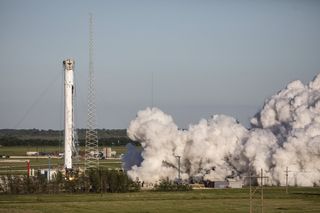
Update, June 24 at 9:20 p.m. EDT: SpaceX has announced they are now targeting a 2:30 a.m. EDT (0630 GMT) launch time, three hours into their original launch window.
We'll all have to wait a little longer to see the Falcon Heavy fly again.
The third-ever launch of the powerful SpaceX rocket has been pushed back at least two days, to June 24 at the earliest, U.S. Air Force officials announced today (June 7).
"Right now, we're finishing up some of the final integration and launch preparation and operations," Lt. Col. Ryan Rose told reporters during a telecon today. Rose is chief of the Small Launch and Targets Division of the Launch Systems Enterprise Directorate, which is based at the Space and Missile Systems Center at Kirtland Air Force Base in New Mexico.
"Right now, we're looking at probably no earlier than June 24 as we complete those activities," she added. "We want to make sure we're ready for a successful launch."
Related: In Photos: NASA's Historic Launch Pad 39A, from Apollo to Shuttle to SpaceX
The upcoming mission, known as STP-2, had been targeted for June 22. It will lift off from historic Pad 39A at NASA's Kennedy Space Center (KSC) in Florida. The four-hour launch window opens at 11:30 p.m. EDT (0330 GMT on June 25).
Get the Space.com Newsletter
Breaking space news, the latest updates on rocket launches, skywatching events and more!
The U.S. military plans to launch its Advanced Extremely High Frequency 5 (AEHF-5) satellite on June 27 from Cape Canaveral Air Force Station, which is next to KSC. So, if STP-2 cannot meet its new target date, the mission may have to wait until after AEHF-5, Air Force officials said.
"The range is pretty crowded in that time frame," STP-2 mission director Walter Lauderdale, of the Falcon Systems & Ops Division, said during today's telecon.
STP-2 is managed by the Air Force via its Space Test Program (the "STP" in STP-2). The mission will launch two dozen satellites, including a NASA atomic clock and LightSail 2, a solar-sailing demonstrator built by the nonprofit Planetary Society.
The Falcon Heavy consists of three modified, strapped-together first stages of SpaceX's workhorse Falcon 9 rocket. A second stage, and the payloads, sit atop the central booster.
These three first stages are all designed to be reusable. Indeed, STP-2 will incorporate the two side boosters from the most recent Falcon Heavy flight, which lofted the ArabSat-6A communications satellite.
During that April 2019 mission, the two side boosters aced their landings at Cape Canaveral Air Force Station. The central core also succeeded, touching down on a SpaceX "drone ship" at sea. But that booster toppled over on the way back to shore, the victim of rough seas.
The other previous Falcon Heavy flight occurred in February 2018. On that demonstration mission, the rocket launched SpaceX founder and CEO Elon Musk's red Tesla Roadster and its mannequin driver, Starman, into orbit around the sun.
- SpaceX's Falcon Heavy: Latest News, Images and Video
- In Photos: SpaceX's 1st Falcon Heavy Rocket Test Launch Success!
- The Evolution of SpaceX's Rockets in Pictures
Space.com Senior Writer Meghan Bartels (@meghanbartels) contributed to this story. Mike Wall's book about the search for alien life, "Out There" (Grand Central Publishing, 2018; illustrated by Karl Tate), is out now. Follow him on Twitter @michaeldwall. Follow us on Twitter @Spacedotcom or Facebook.
Join our Space Forums to keep talking space on the latest missions, night sky and more! And if you have a news tip, correction or comment, let us know at: community@space.com.

Michael Wall is a Senior Space Writer with Space.com and joined the team in 2010. He primarily covers exoplanets, spaceflight and military space, but has been known to dabble in the space art beat. His book about the search for alien life, "Out There," was published on Nov. 13, 2018. Before becoming a science writer, Michael worked as a herpetologist and wildlife biologist. He has a Ph.D. in evolutionary biology from the University of Sydney, Australia, a bachelor's degree from the University of Arizona, and a graduate certificate in science writing from the University of California, Santa Cruz. To find out what his latest project is, you can follow Michael on Twitter.